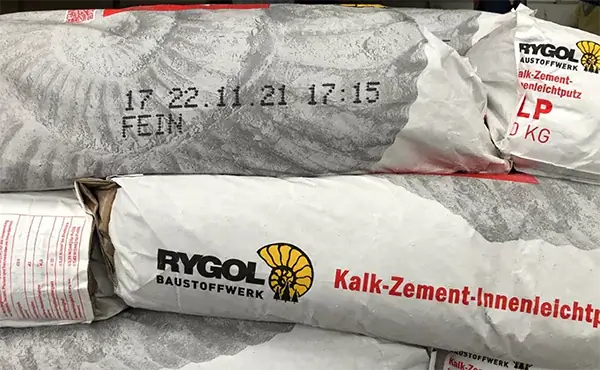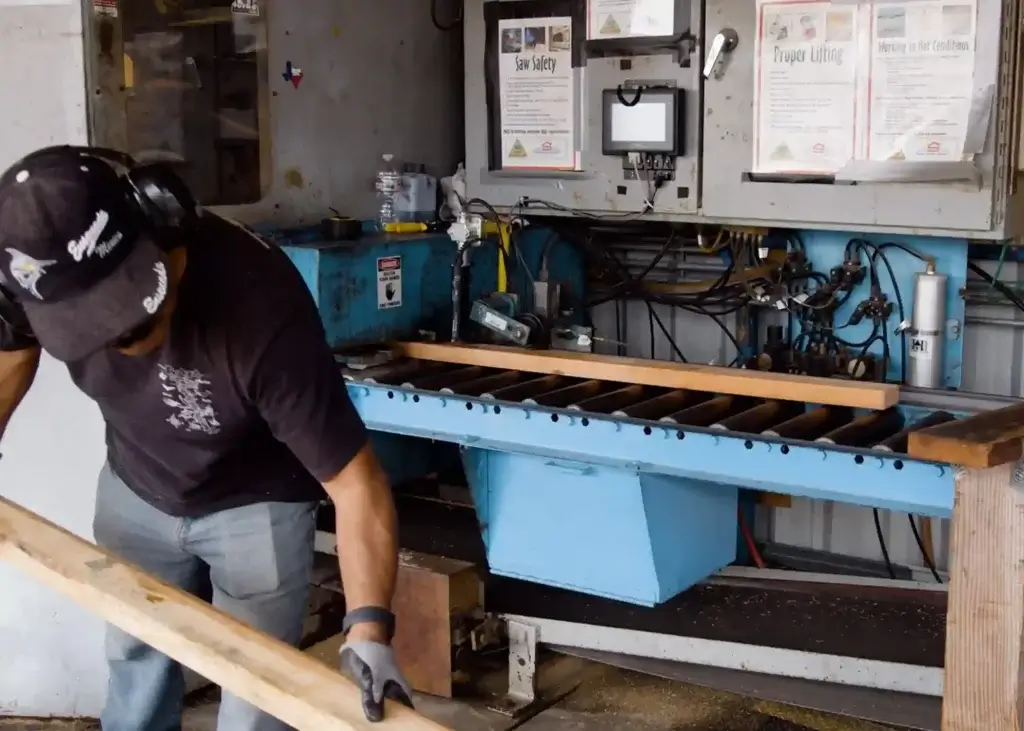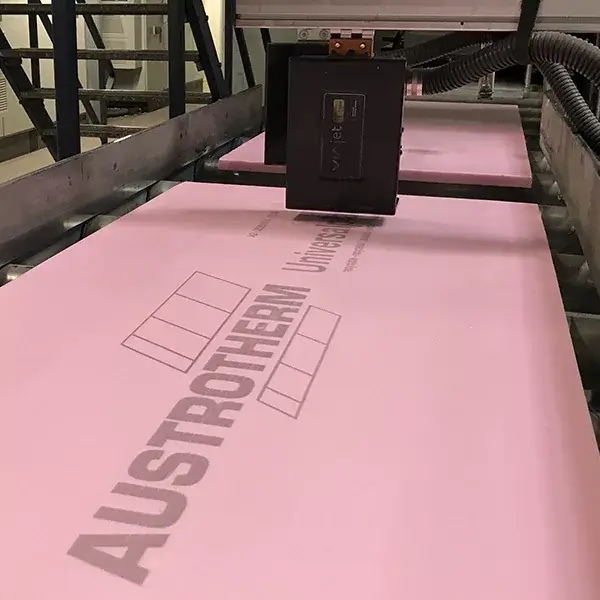Battling it out for industrial building products marking supremacy
By Kevin Havre
Still using manual or other outdated methods to mark building products? It may be time to break away from the competition and upgrade your marking technology and processes.
Manual marking on your building materials and products is inefficient and leads to errors and high consumables costs; especially when volumes increase.
But rushing into digital marking and coding equipment isn’t the answer without thorough research. Marking equipment needs to tick very specific boxes for building products manufacturing, spanning everything: engineered wood products, roofing materials, insulation, stone products and bags of materials such as cement and grout.
One constant across the board, however, is the need to deal with harsh production environments, different size materials, and the universal need for durable, legible marks to meet compliance and tracking regulations.
To help you work out the best marking technology for your building products manufacturing operation, we take a look at the most popular marking options in a head-to-head showdown.
In the ring, we’ve got continuous inkjet (CIJ) vs valvejet drop-on-demand (DOD) vs thermal inkjet (TIJ) vs piezo inkjet (PIJ).
Let’s match them up:
Round One: Harsh environments
Dust, extreme temperatures, and exposure to various chemicals and oils – building product manufacturing environments are harsh. We’re talking about printing lot codes onto bags of cement on a dusty conveyor, placing data matrix codes on metal roofing materials, or precise point-of-sale data onto stick lumber with heaps of sawdust in the air.
Traditional marking technologies struggle to maintain performance in demanding and harsh settings, leading to marks that aren’t legible or durable, not to mention machine failures or excessive maintenance costs.
CIJ printers are susceptible to failure in the face of contamination or temperature extremes. Sierra Aluminum, for example, found that its CIJ printers required extensive ongoing maintenance under the harsh conditions in the company’s plant, leading to downtime that drove up costs. Printer malfunctions would delay customer orders, which damaged customer relationships and their brand reputation. Read how they switched equipment for a 50% efficiency boost.
The problem is that CIJs have a continuous stream of ink spraying from the printhead’s nozzle, most of which ends up in the printhead’s gutter to be returned to the ink supply. When there’s excessive dust and debris, it can end up in the ink or print nozzle, leading to quality and maintenance problems. While CIJ printer manufacturers have devised systems such as positive air to reduce contamination problems, CIJ print nozzles still must be cleaned daily before shutting down, adding an extra layer of maintenance.
But you’ll find a champion in drop-on-demand printers, particularly valvejet. Only valvejet can thrive with minimal maintenance in the most demanding industrial applications. High temperatures, dust, exposure to chemicals – you name it, valvejet technology will stand up to the test and deliver consistent and legible marks. When Sierra Aluminum upgraded to valvejet, they achieved 50% improved efficiency, lower costs, and an anticipated one-year return on investment.
For example, the V-Series drop-on-demand printhead features a rugged design that meets the demands of extreme environments for steel, lumber, concrete and gypsum. It can withstand high temperatures up to 200°C/392°F. The incredible reliability of valvejet technology in the harshest industrial environments delivers increased uptime on your production line, which translates to real dollars to your bottom line.
Round One Verdict: Valvejet DOD wins this round by knockout!

Round Two: Materials
Building products are rarely uniform in shape, size and materials. And when you have surfaces that vary from smooth to rough, porous to non-porous, curved to flat, you need a marking technology that can handle practically anything.
The ideal marking technology should offer flexibility and adaptability to cater to the specific needs of different building products.
Valvejet versatility wins hands down. Valvejet printers have a long throw distance – the distance between the printhead and the item to be marked – meaning they can mark clearly and precisely on various surfaces.
What about other drop-on-demand inkjet technologies like TIJ and PIJ? Most thermal inkjet printheads have a fairly short throw distance, meaning the product must be moving in a smooth manner. Piezo inkjet has a longer throw distance but cannot mark on non-porous substrates. Valvejet printers can deal with longer throw distances to accommodate uneven or bumpy production lines.
CIJ printers also can support longer throw distances, which makes them good for marking on oddly shaped products and those that shift or bounce on the line. They can also work at faster speeds than PIJ and TIJ. But their inability to perform reliably in harsh environments is a huge negative.

To win the round, valvejet printers are also adaptable to production requirements, not the other way around. Printheads can be mounted anywhere they are needed on the production line and even on robotic arms for ultimate marking adaptability.
Leading truss supplier Stone Truss processes an extensive range of lumber sizes and shapes and chose the V-Series printer for increased efficiency. The V-Series printheads print easily readable large character marks on all the lumber Stone Truss runs through its saws, significantly improving productivity. Read more about how they achieved a 15% productivity gain by implementing the V-Series system.
Round two: Valvejet notches another win
Round 3: Meet customer and regulatory requirements
Properly applied, legible, and durable: these are the marking mandates for customers and regulators. Inaccurate, smeared, or faded markings can lead to compliance issues and compromise the overall quality of the building product.
Worse, smeared, or illegible codes can result in costly legal action and misplaced, misrouted, and unsold items that aren’t correctly inventoried. They can also compromise your brand reputation, as low-quality marks reflect on your product quality and your company’s processes. The impact a smudged mark can have on your bottom line may be hard to measure, but even so it’s not worth the risk.
TIJ and PIJ printers stand out in applications that require higher-resolution marks, such as logos, barcodes or 2D codes. For clean, temperature-controller facilities, they can perform well. CIJ can only create small characters, limiting its usefulness for many industrial applications that require human-readable larger character marks.

Valvejet is once again the outright winner for most industrial applications. The V-Series can mark variable data, simple text, and medium-resolution graphics including bar codes with large character sizes. It’s also possible to stitch printheads together to produce much larger marks.
Back to Stone Truss. The clear and legible prints from the Matthews V-Series valvejet printers make it easy for the builders to identify the pieces needed for assembling trusses rather than struggling to read handwritten codes.
Durability is critical, and valvejet printers are known to mark porous and non-porous substrates with precise, high-quality, and long-lasting codes. In the case of V-Series printers, the valves flush automatically, meaning you avoid the build-up of residue that can cause bad marks.
Round three: Valvejet takes it on versatility
The Verdict
Valvejet technology wins hands down for marking a vast array of building products, including engineered wood, dimensional lumber, sheetrock, insulation, steel, roofing, stone, and more.
Valvejet will ensure your marks tick the customer and compliance boxes and put your reputation ahead of the competition. Best of all, its proven performance in tough production environments means you won’t have to grapple with the costs of maintenance and downtime. It’s an all-round winner for your bottom line.
Get a Free Consultation
Matthews is the proud inventor of valvejet technology, and we are still the industry leader today. There’s no one better placed to provide a tailored solution for your building product marking. A 15-minute call is all it takes to find the best marking solution for your products. Fill out the form below and we’ll do the rest.
